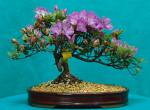Bookmark This Site
When starting your own bonsai you will want to style the bonsai to fit the type of tree you are growing. It helps to observe how trees grow in nature since that will help you design a real looking miniature tree. You will also want to choose a pot that will complement the tree.
Bonsai Pots
For example, pots that have sharp corners and straight sides are usually used for formally-shaped plants whereas round or oval pots are for informal designs.
You also want to consider the pot finish,color,and size. Generally deciduous trees (refers to trees that lose their leaves seasonally) are grown in glazed pots and evergreen (are plants that have leaves all year) grown in unglazed pots.
Bonsai Pots
There are many different styles of bonsai. I am going to mention five common and popular styles. Bonsai Pots

The first style I want to talk about is the formal upright style (Chokkan). In this style the tree is upright, straight with a tapering trunk. The branches are broadest at the bottem and taper to the shortest at the top. This is the bonsai above.
The next style is informal upright style (Moyogi). The top of the tree is always directly above the trunk at the soil line. The trunk is irregular shape and the branches are similar to the formal upright except that the shape of the irregular trunk may break the progression of the branches by causing them to be uniquely obscure or prominent.
The third style is slant style (Shakan). The trunk of this bonsai is basically straight but is slanted.
The fourth is the cascade style (Kengai). These bonsai are made to look like trees that grow on the sides of mountains or over water.
Semi cascade style (Han Kengai) bonsai sticks out over or/and beneath the edge of the pot.

To style your formal upright tree you need to see where the main roots start by removing the surface soil. Cut away old leaves and leaves growing at the bottom of the branches.Look at your tree and decide which side you want to be the front. The front is when the branches and roots are not sticking out towards you. To shape your bonsai choose the branches you would like to use in the design. The purpose is to make it look like a real miniature tree. You want gaps between the foliage. The first branch should be about 1/3rd of the way up the trunk to the left or right. The other branches should be a little above the ones below and sticking out in different directions but not directly opposite or at the same level. Remove the branches you don't want. The desired shape of the tree is triangular but doesn't have to be perfect in that shape. You will want to trim your branches so they are longer at the bottom and tapper shorter at the top.
Have fun!
Books about bonsai.
Click here
. Bonsai Tools
Bonsai Tools & Wire
I hope the information in this blog helped you. Thanks for visiting.









